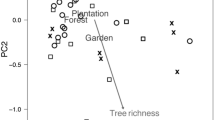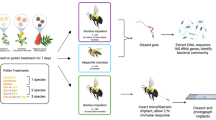Abstract
Many species of the dioecious, neo-tropical plant genus Clusia secrete a viscous, hydrophobic resin from glandular tissues in both male and female flowers. This substance is readily gathered by meliponine and euglossine bees for whom it most often serves as the sole pollinator reward. Bees use Clusia resin as a nest-building material. As such, resin clearly serves an indispensable mechanical function. However, resins with antimicrobial properties may also serve to reduce the risk of pathogenesis in the nest. If resin-gathering apids benefit from antimicrobial properties in nesting materials and are able to discern these characteristics in the forage they gather, one might predict that the resin reward presented in Clusia could have evolved under selection for both mechanical and antimicrobial properties. In dioecious species, where females and males each present a resin reward, selection regimes may differ between the sexes with the result that resin form and function diverge. We investigated both the form and function of the male and female pollinator reward resins of Clusia grandiflora. Using thin-layer chromatography (TLC), we compared the chemical compositions of floral resins from five widely separated populations of this species growing in southeastern Venezuela. We found that male and female resins exhibited a marked chemical dimorphism, with females having two major TLC-resolvable fractions and males having seven. This dimorphism was stable: there were no component differences between populations in either sex. Using a disk-diffusion technique, we surveyed the same resins for antimicrobial activity using assay microorganisms isolated from eusocial meliponine bees. Both male and female Clusia grandiflora resins had pronounced but relatively directed antimicrobial activity: both were toxic to 10 of 11 Gram-positive bacteria, 7 of 15 Gram-negative or variably-staining bacteria, 0 of 3 yeasts, and 0 of 3 filamentous fungi. Again with the disk-diffusion technique, we performed more detailed tests of resin bioactivity using two Gram-positive honeybee associates, Paenibacillus larvae and P. alvei, as model pathogens. Both male and female C. grandiflora resins were highly toxic to these honeybee pathogens. Female resin, however, produced zones of inhibition with more than twice the mean diameter of those produced by the male resin. This divergence in form and function of the C. grandiflora pollinator reward resins could be in response to different selective regimes as mediated by the pollinating insects.
Similar content being viewed by others
Author information
Authors and Affiliations
Additional information
Received: 19 October 1998 / Accepted: 9 February 1999
Rights and permissions
About this article
Cite this article
Lokvam, J., Braddock, J. Anti-bacterial function in the sexually dimorphic pollinator rewards of Clusia grandiflora (Clusiaceae). Oecologia 119, 534–540 (1999). https://doi.org/10.1007/s004420050816
Issue Date:
DOI: https://doi.org/10.1007/s004420050816




